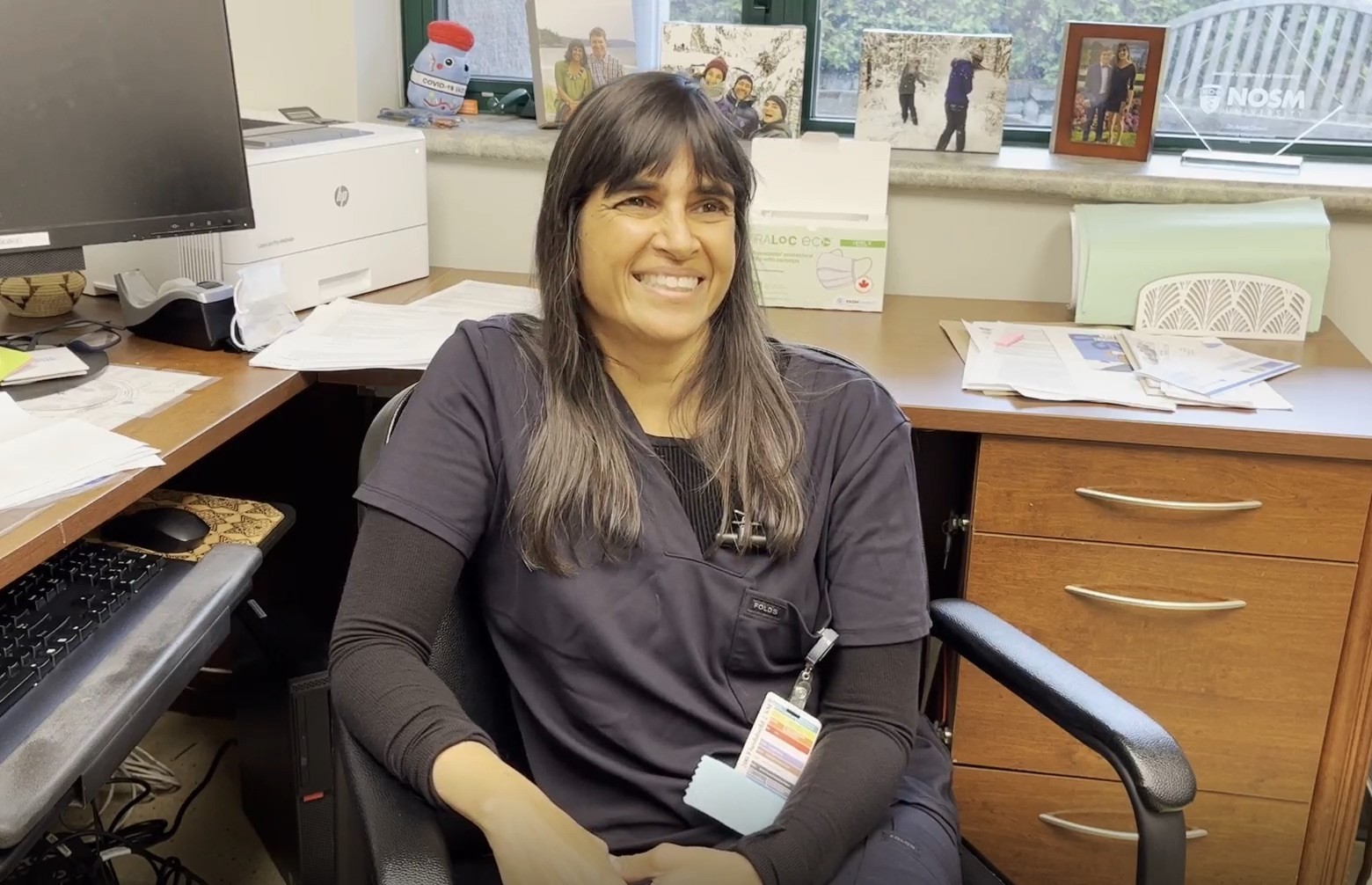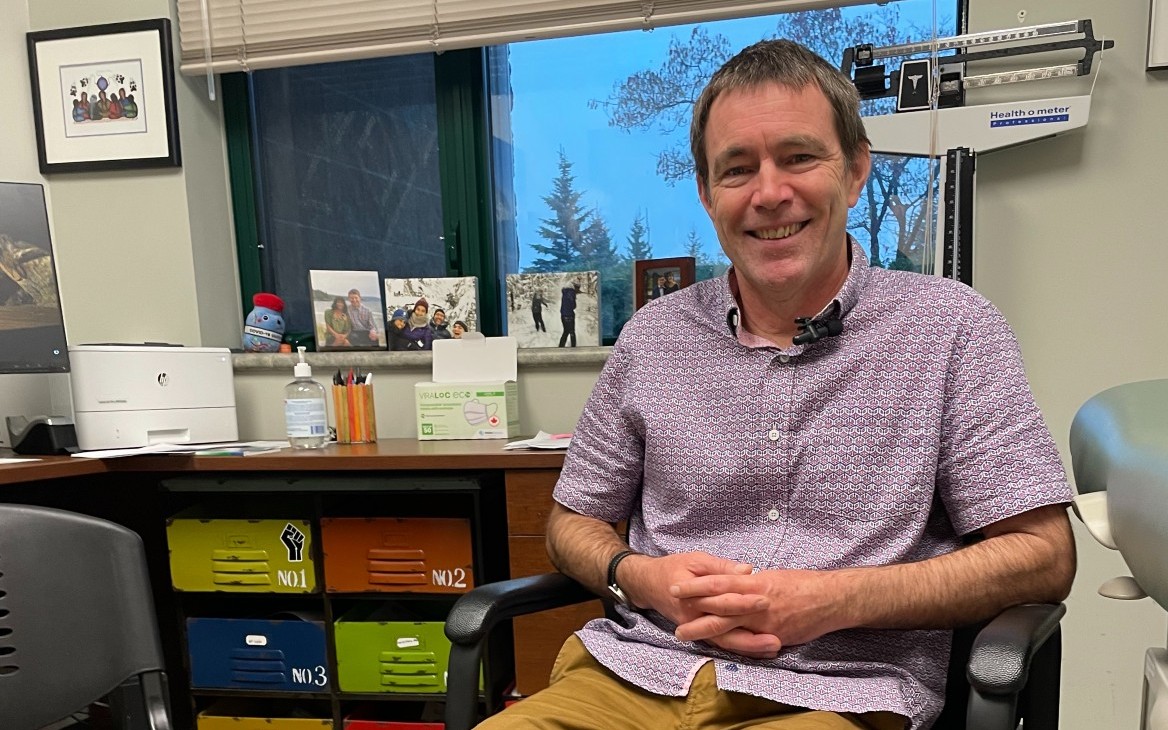Two-part series explores the chronic physician shortage in northern Ontario and the steps being taken to recruit more doctors
 For rural generalists Drs. Anjali Oberai and Mike Cotterill, practising in northern Ontario was once blissful and balanced.
For rural generalists Drs. Anjali Oberai and Mike Cotterill, practising in northern Ontario was once blissful and balanced.
Arriving in Wawa in 1996 as newlyweds and new family physicians, they embarked on an eye-opening four-week locum placement at the town’s only hospital, Lady Dunn Health Centre. The hospital serves more than 4,300 residents in Wawa and its surrounding communities: Dubreuilville, Hawk Junction, Michipicoten First Nation, Michipicoten Township-Wawa, Missanabie and White River. Locum physicians are a vital resource for the hospital, providing permanent physicians with necessary leaves of absence from their practices for illness, continuing education, vacation and parental leave, for example.
Drs. Oberai and Cotterill were enamoured with the area’s beauty – forested hills, sandy shorelines, rivers, waterfalls and the infamous Wawa goose monument. The couple grew up in eastern Ontario – Dr. Oberai in Kingston and Dr. Cotterill in Almonte, near Ottawa – and are both graduates of the University of Ottawa’s faculty of medicine.
“We’re kind of accidental rural physicians in that we didn’t train rurally or work rurally prior to coming here,” Dr. Oberai said in an interview at Lady Dunn. “We really fell in love with the area and fell in love with the work. We moved here in 1998 and we’ve been here ever since.”
Ever since has included raising two children – family photos of outdoor adventures line the window ledge of Dr. Oberai’s office – and forging a deep connection with the community. The doctors are often greeted by patients at the grocery store or post office and offered gifts of fresh fish or wild game.
“It’s a really nice mix to know our patients as patients in the clinic but also to know them in the community,” Dr. Oberai said. “I hope that patients also see me more as a human being.”
Until recently, the now empty nesters were the only two permanent physicians left on the family health team at Lady Dunn. Another physician has recently signed on full-time after first onboarding as a locum.
But three doctors are a far cry from the six full-time physicians the community had prior to the COVID-19 pandemic. That is the maximum number allocated to the community through the province’s Rural and Northern Physician Group Agreement, introduced by government in 1996 to address the physician shortage in northern communities.
Since 2019, Lady Dunn’s health team has seen its physician roster dwindle. Another physician couple left during the COVID-19 pandemic to be closer to family. Last June, one physician relocated to Ottawa to care for his elderly parents. Last September, one more physician stopped practising, citing reasons connected to burnout.
“The collegiality and having other doctors to bounce things off is missing,” said Dr. Cotterill.
Nursing and paramedic shortages have exacerbated the problem.
Prior to the pandemic, in addition to the six full-time physicians, the family health team had two nurse practitioners, three registered nurses, a part-time dietitian shared between the primary care clinic and the emergency department, and one social worker. Today, family health team support remains, less a social worker. Ongoing locum support and agency nurses are used to fill in the gaps. The shortage of physicians and nurse practitioners is leading to less clinic appointments and more patients showing up in emergency, explained Oberai.
The Lady Dunn Health Centre used to offer more comprehensive care, with a full-service obstetrics program, a general surgeon and an anesthetist on staff.
“It made for a really nice working environment. Work-life balance was really, really good,” added Dr. Oberai, who coached a cross-country team and rarely missed her children’s activities or events growing up.
No one has a finger on the pulse of the issues affecting physicians and patients like you do. Help us rebuild health care in Ontario.

“The challenges are also the gifts in this job in that sometimes you do feel like you’re torn or being pulled in many different places, but it definitely keeps the work interesting”
— Dr. Anjali Oberai
But retention issues have impacted the availability of health-care services, such as obstetrics and surgeries, as physicians retire, resign or relocate. There has also been a decline in physician interest to practice obstetrics, Dr. Oberai said. A lack of nursing support, she added, limits surgical procedures offered including colonoscopies and gastroscopies.
As rural generalists, Drs. Oberai and Cotterill encounter a wide range of clinical scenarios not usually seen in urban family practices. Their days are busy and diverse, including 24-hour emergency department shifts (where they are on-call but come and go as needed), in-patient rotations, minor surgical procedures along with home visits to wrap up a day. Dr. Oberai also performs stress testing, while Dr. Cotterill is an endoscopist conducting procedures in Wawa and at other area clinics. It’s like being a "Jack of all trades" in medicine, he said.
Dr. Oberai sees the varied skills of rural generalists as a blessing, making them better physicians overall.
“The challenges are also the gifts in this job in that sometimes you do feel like you’re torn or being pulled in many different places, but it definitely keeps the work interesting.”
The challenges they face in providing proper care to their patients are part of a primary care crisis being felt across Ontario, but particularly in the north.
According to INSPIRE-PHC research, as of September 2022, 2.3 million Ontarians were without a family doctor, up from 1.8 million in March 2020. This figure is expected to more than double by 2026, reports the Ontario College of Family Physicians. Meanwhile, in northern Ontario alone, half of the physicians are expected to retire in the next five years, according to a Northern Ontario School of Medicine University report.
“For years everybody had a doctor or nurse practitioner here. Now there are more orphaned patients,” Dr. Cotterill said. He and his wife also have to rely on care from locums or the nurse practitioners after losing their own family doctor.
The Lady Dunn Health Centre may seem quiet, much like the town in which it’s situated. Just a few patients were waiting for care in its 24-hour emergency department on a recent morning.
Though it doesn’t experience the over-crowding and wait times of urban hospitals, an on-site same-day, walk-in primary care clinic run by the nursing team calls on the on-call emergency physician for support when things get busy and for the final assessment before patients are discharged. They are managing both the non-urgent walk-ins and urgent matters.
“You’re keeping a lot of balls in the air and you’re going back and forth as there are a lot of people who want to talk to you during the day,” Dr. Cotterill said.
With limited diagnostics and testing and no permanent specialists on site, quality of care can be affected, as patients may arrive with a range of health issues, from minor to serious. “Anybody who walks through the door with an illness, anyone who presents to the emergency room, we have to figure out what to do with them,” he said.
Patients must also travel to Sault Ste. Marie (more than 250 kilometres away), Sudbury (530 km away) or as far as southern Ontario to access a CT scan or MRI. Minimal obstetrics services require expectant mothers to deliver their babies out of town.
Dr. Oberai, who has obstetrics expertise and facilitates nursing obstetrics training once a year at Lady Dunn, delivers babies in emergency situations when a woman arrives in labour and a transfer is deemed unsafe. Typically, expectant mothers schedule pre-natal appointments in Sault Ste. Marie and need to spend up to two weeks there prior to their due date to ensure a safe delivery. Financial constraints and other logistics such as finding accommodation in Sault St. Marie and transportation to and from Wawa may be difficult to arrange for expectant mothers.
“That’s costly for one thing and inconvenient for another and may not be possible depending on a mom’s life situation,” Dr. Cotterill said. “That could affect health outcomes, for sure.”
Other logistical challenges include weather-related shutdowns of roads and regional airports, particularly in the winter. Medical Air Service and Ornge provide transport for urgent care that can’t be handled locally at the Wawa Municipal Airport. They arrange the planes and level of paramedics required for patient transfer. But a shortage of air ambulances, pilots and paramedics has led to delays and challenges co-ordinating with out-of-area hospitals, Dr. Cotterill explained.
He recalls one case when he treated a patient with severe and chronic mental health issues, who was acting aggressively. Though the patient was accepted for transfer to Sault Ste. Marie, transportation was delayed. The patient had to be confined against their will and police had to be on-site at the health centre for much of 24 hours.
“Luckily there were no bad outcomes for the patient or other patients. But it would have been so much better for that patient and for the rest of us involved in their care had the transfer been able to happen sooner,” Dr. Cotterill said. “I don’t blame any individual, but it was stressful and not a good use of anyone’s time. There was moral distress there on all our parts.”

“For years everybody had a doctor or nurse practitioner here. Now there are more orphaned patients"
— Dr. Mike Cotterill
Efforts are underway to increase the number of doctors in the region.
NOSM University is working with northern Ontario communities to help them recruit more than 350 physicians, including more than 200 family doctors, to the north. The university encourages its medical students to stay in the north post-graduation and requires them to complete placements in the region’s communities, including at Lady Dunn. The Ontario Medical Association is advocating for the government to build a northern and rural physician workforce strategy, as part of its Prescription for Ontario: Doctors’ Solutions for Immediate Action report.
Ann Fenlon, a physician recruiter since 2021 and former pharmacist in Wawa, devotes her time to sourcing permanent and locum physicians at Lady Dunn. Recent efforts have led to the new permanent physician placement, as well as a schedule of shorter-term locum coverage. Longer-term placements are typically done by returning locums, where a relationship has been established between the locum and the family health team, providing continuity of care at the hospital.
“Without the locums here to provide the care in the vacant practices and also to supplement coverage in our emergency departments, we would not be able to sustain or retain our core physicians who are still here,” she said. “We’re always hoping that somebody’s going to love it here and want to stay, so we have to widen the net to make sure we can bring enough people in that we’ll find the one that’s the right fit.”
For Drs. Oberai and Cotterill, locum support has been critical to them continuing to practise in the area.
“If we hadn’t had this locum support that we’ve had, I don’t think Mike and I would still be working here. So that’s really what’s kept us afloat.”
But Drs. Oberai, 55, and Cotterill, 56, worry about the future. They are reluctant to make firm retirement plans for fear of leaving their patients stranded without adequate care. Even now, they have limited freedom to come and go from Wawa.
“We’re very much attached to the community, to our practice, to our staff. Leaving without there being people to take our place is very difficult,” Dr. Oberai said.
But visiting loved ones has become a greater priority, with their parents now elderly and still residing in Kingston and Almonte. Their son moves between Waterloo and Toronto and their daughter is overseas in Zurich, Switzerland for two years.
Dr. Oberai assists the recruiter in establishing what locum coverage is needed. “We have Ann, who’s a great recruiter. Right now, there just don’t seem to be enough family doctors out there, so recruitment is challenging for all communities, whether it be urban or rural,” she said. “But I’m hopeful that in the next few years things will change. So, we’ll see. Fingers crossed.”
In the meantime, it’s the connection to their patients that motivates these doctors to continue living and practising in the community they’ve served for more than 25 years. And there’s always the beautiful landscape for grounding and inspiration.
“I think we live in one of the most beautiful parts of Ontario,” Dr. Cotterill said.
“I can be cross-country skiing, hiking or mountain-biking after work. Traffic consists of waiting for two cars to go by at an intersection. My commute is zero. This has helped me cope. I couldn’t survive without those things.”
In part two of Northern Exposure, we explore the workings of Ontario’s locum system and how it supports health care in the province’s north.
Photo credit for all photos: Sophie Nicholls Jones